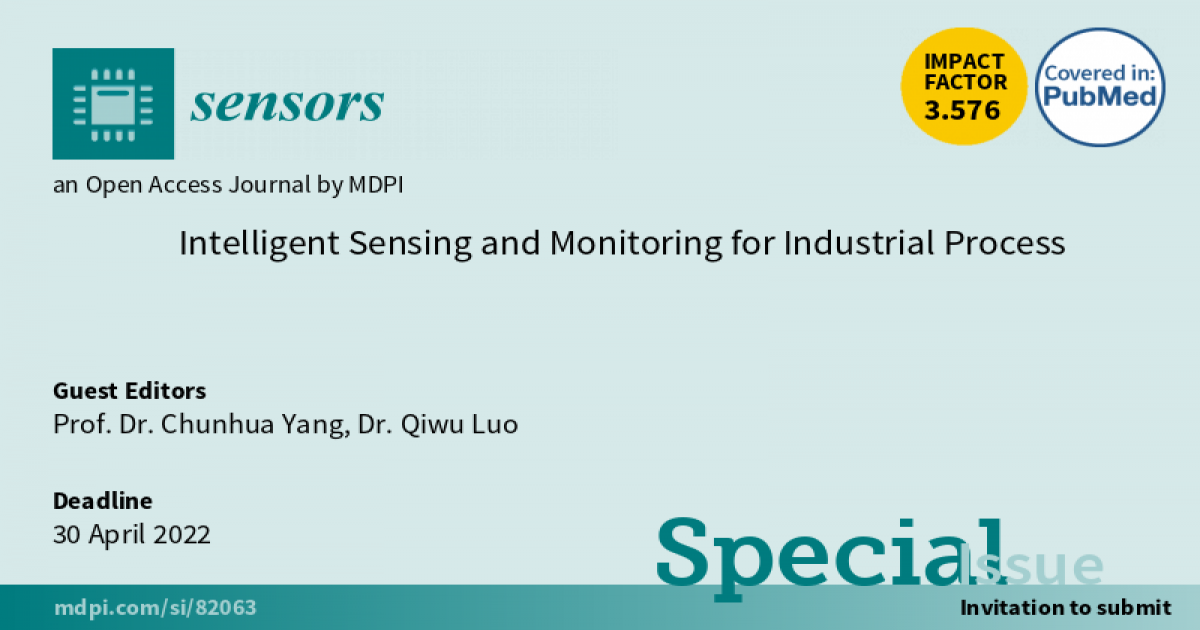Intelligent Sensing and Monitoring for Industrial Process
A special issue of Sensors (ISSN 1424-8220). This special issue belongs to the section "Intelligent Sensors".
Deadline for manuscript submissions: closed (30 April 2022) | Viewed by 23311

Special Issue Editors
Interests: intelligent sensing and automatic device; process modeling and optimal control; industrial big data analysis and deep learning; smart manufacturing for process industry
Special Issues, Collections and Topics in MDPI journals
Special Issue Information
Dear Colleagues,
Intelligent sensing and monitoring plug intelligent wings into the traditional industries. They provide key data feedback for production quality monitoring and operational controls of the industrial process, which is crucial for efficient control, energy saving and emission reduction of the production process. However, industrial detection faces harsh environments and complex processes, which leads to difficulties in obtaining and analyzing vital information in the industrial process. The intelligent sensing and smart algorithms have potential advantages in breaking through the limitations of conventional detection methods, overcoming the challenges of strong interference in the complicated industrial processes, accurately extracting key features, and intelligently analyzing industrial information.
In this present Special Issue, we invite papers on intelligent sensing and monitoring for industrial application scenarios. The purposes of the Special Issue are to collect contributions in the methodologies and systems of spectral analysis, laser-based measurement, visual-based inspection, and so on, to serve as a forum for researchers in the field of sensing technologies and signal processing strategies, and to promote the developments of automatic inspection of product quality and intelligent control of industrial processes. Theoretical and experimental works are both welcome, aimed at providing a series of state-of-the-art approaches to extract informative features, to realize smart signal processing from weak and noisy raw data, and to move towards the progression of noise-robust and environment-adaptive monitoring techniques. Critical reviews and surveys of the cutting-edge and practice are also encouraged.
Prof. Dr. Chunhua Yang
Dr. Qiwu Luo
Guest Editors
If you want to learn more information or need any advice, you can contact the Special Issue Editor Jessica Zhou via <jessica.zhou@mdpi.com> directly.
Manuscript Submission Information
Manuscripts should be submitted online at www.mdpi.com by registering and logging in to this website. Once you are registered, click here to go to the submission form. Manuscripts can be submitted until the deadline. All submissions that pass pre-check are peer-reviewed. Accepted papers will be published continuously in the journal (as soon as accepted) and will be listed together on the special issue website. Research articles, review articles as well as short communications are invited. For planned papers, a title and short abstract (about 100 words) can be sent to the Editorial Office for announcement on this website.
Submitted manuscripts should not have been published previously, nor be under consideration for publication elsewhere (except conference proceedings papers). All manuscripts are thoroughly refereed through a single-blind peer-review process. A guide for authors and other relevant information for submission of manuscripts is available on the Instructions for Authors page. Sensors is an international peer-reviewed open access semimonthly journal published by MDPI.
Please visit the Instructions for Authors page before submitting a manuscript. The Article Processing Charge (APC) for publication in this open access journal is 2600 CHF (Swiss Francs). Submitted papers should be well formatted and use good English. Authors may use MDPI's English editing service prior to publication or during author revisions.
Keywords
- TDLAS-based measurement
- laser-based measurement
- spectral analysis
- trace gas detection
- automated visual inspection
- in-situ defect detection
- combustion diagnosis
- particle measurement
- portable instrument
- holography
- interferometry







